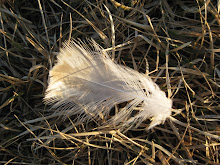Thursday, April 28, 2005
The Worm Bin
While flipping over rocks at Three Sisters today, I was delighted to come upon several red wrigglers! I had been searching through manure the past few months for the critters to no avail. Now that spring has sprung they are everywhere, wriggling through the wet soil up into the sun. Now I can start my worm bin. What is a worm bin, you may ask? I certainly had no idea before I went to EAT. The purpose of a worm bin is to create worm casings which you can use fertilizer, either putting them directly onto your plants or by brewing worm tea. They are easy to make. Just get a garbage can and poke some holes in it so the worms can breathe. Toss in some newspaper and some food scraps and some red wrigglers, and the worms will do their thing, digesting your food scraps into succulent casings. It sounds grosser than it is. The casings actually look and feel just like soil, not like the manure which they actually are. A worm bin is more practical than a compost pile if you live in a city. You can put it in your basement or under your kitchen sink. The worms should be red wrigglers, not the larger earth worms. Red wrigglers can be mail-ordered, purchased from a bait shop, or dug yourself--horse manure is a good place to look. To make worm tea take a handful of casings and add it to a five gallon bucket of water. AT EAT we dumped in two bottles of blackstrap molasses as well, since the sugar promotes bacterial growth. The tea should be aerated by stirring it for an hour or by hooking it up to a pump (like for an aquarium) if you don't want to do it yourself. Here on BI, a wormbin is economical as well, since we have to pay for our trash by weight at the dump. Plus you get to have pets!
Subscribe to:
Post Comments (Atom)

No comments:
Post a Comment